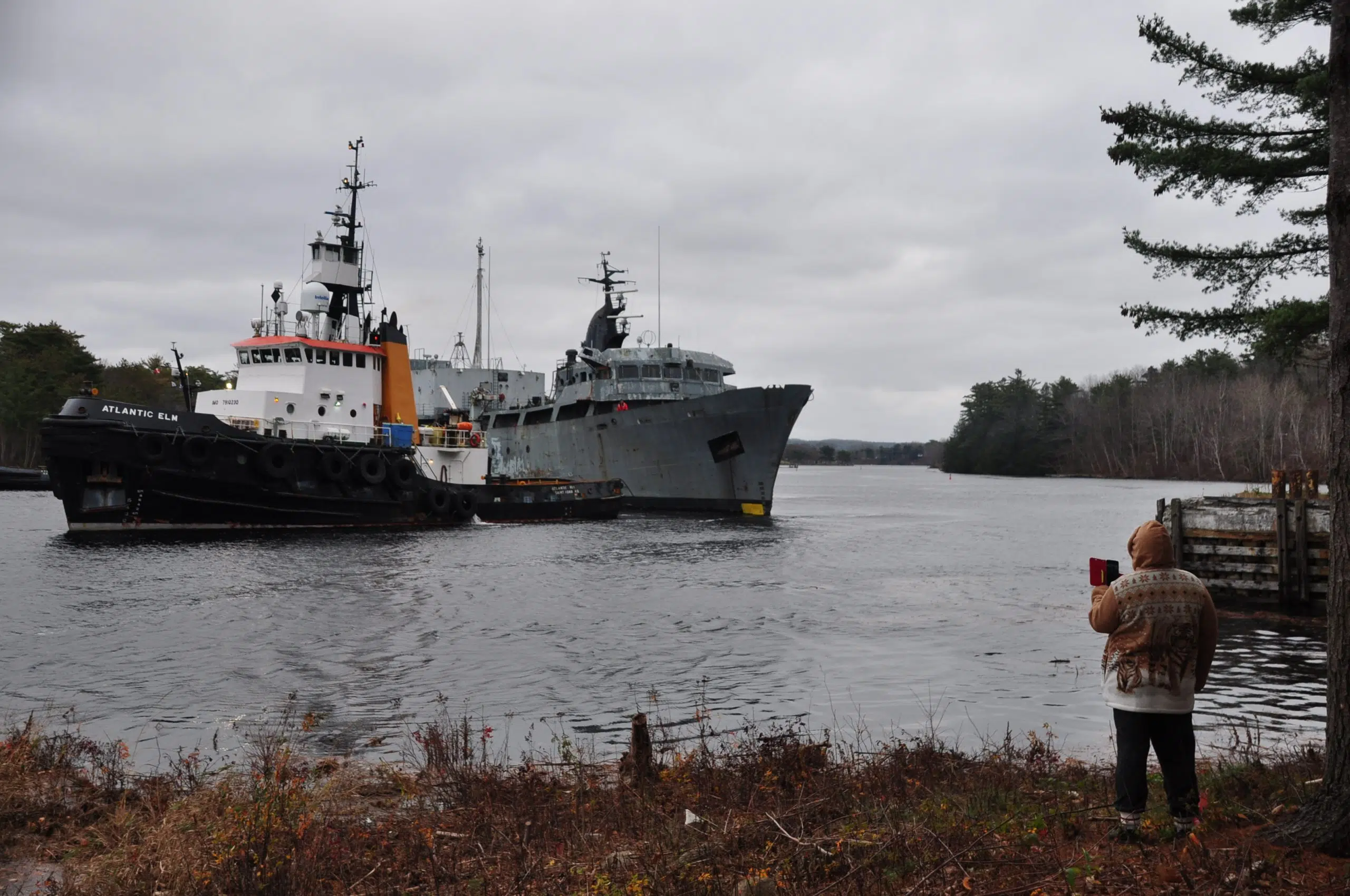Its the end of an era – The former HMCS Cormorant has left Bridgewater.
The derelict vessel ended its 20-year stay in the LaHave this morning after two Canadian Coast Guard tugboats hauled it down the river to the delight of many Bridgewater residents.
To many, locals and government officials alike, it was a relief to finally see it go.
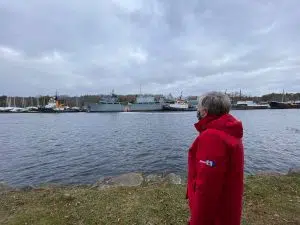
Bernadette Jordan, Minister of Oceans, Fishery and the Canadian Coast Guard, says finally being able to say goodbye to the Cormorant is a relief. PHOTO: Cody McEachern
“Its been a challenge, there’s no question,” said Bernadette Jordan, Minister of Oceans, Fishery and the Canadian Coast Guard.
“However, its important to everybody because this (ship) is an environmental hazard right now and we want to make sure that we are dealing with all of the environmental challenges we see in this river. This is a big one, and we are really happy to see it go today.”
Jordan, as well as Coast Guard officials, town representatives and many members of the public lined the banks of the LaHave to watch as the ship was moved away from the Bridgewater Port, something it hasn’t done in almost 20 years.
A Historic Ship Left To Rot
According to an online ship index, The HMCS Cormorant was built in Italy in the mid-sixties before being brought to Canada and converted to a diving support vessel for the Royal Canadian Navy in 1978.
Two years later, it became the first co-ed crew vessel in Canada, welcoming eight women sailors on board.
The ship was instrumental in the 1989 discovery of the sunken Breadalbane, which had been missing since 1853, as well as the recovery of the SS Edmund Fitzgerald’s bell in Lake Superior in 1994.
However after being decommissioned in 1997, the ship was sold off to a United States based owner and was docked in Bridgewater. It then switched hands a number of times and became the focus of a legal battle to determine ownership of the vessel.
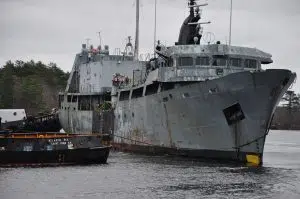
The left side of the Cormorant displays much of the damage it sustained after sinking in 2015 and leaning against the port. PHOTO: Cody McEachern
The ship began listing heavily to the side following a heavy snowfall in 2015, and eventually sank to the bottom of the LaHave, leaking pollutants into the river.
After being refloated in 2015 by the Coast Guard, the federal government announced in 2019 they would begin the process of assessing and removing the ship In December, results of that assessment came in, deeming the ship a pollution threat.
Removing Ship Not an Easy Process
Getting the decaying ship prepared for its final voyage was no easy feat, as the ship had to be made safe before being removed.
Canadian Coast Guard crews landed at the port 28 days ago after a successful bidder had been granted the contract to destroy the Cormorant.
During that time, crews had to drain an estimated 8,500 litres of oil-contaminated water and 6,500 litres of oil from the ship before the tow, among other work.
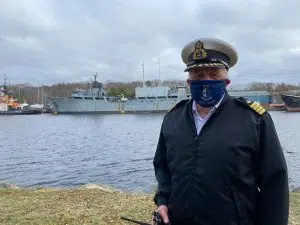
Dan Nickle, acting incident management regional director for the coast guard says lots of planning and work was done to make sure the ship was safe to tow. PHOTO: Cody McEachern
“They had to do considerable work to the ship to stabilize it and put it on an even trim,” said Dan Nickle, acting incident management regional director for the Coast Guard.
“They’ve secured the propellers and the rudder mid-ship, blocked all the sea bays and secured all the hatches to make sure everything was safe.”
The cost for removing the ship is costing the federal government around $1.8 million, with further costs being attributed to the clean-up and preparation.
“To that, I would say though, what would it cost if it sank again?” said Jordan on the cost of removal.
“That’s where we have a really big concern is if this were to sink again, it would cost much more than $1.8 million. So making sure we are dealing with the problem is a priority for us.”
When it comes to getting that money back, Jordan said the threat of pollution and the ship potentially sinking again outweighs that for now.
Her focus, and the focus of the Coast Guard, is on getting the ship safely to its destination in Sheet Harbour where it will be torn down.
That trip is estimated to take around 24 hours, and can be tracked on the Marine Traffic website.
Still More Work To Be Done
While the Bridgewater Port looks more empty than it has in the last 20 years, many are still wondering what is to become of the two rusting trawlers docked on the LaHave.
Jordan said the other two ships at the port aren’t quite on the radar yet, as the focus has long been on the Cormorant.
“Of course, we as a government believe strongly in making sure we address the problem of abandoned and derelict vessels,” she said, “We will continue to work on long term solutions for other vessels as well.”
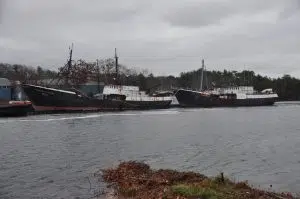
The Hannah Atlantic and the Ryan Atlantic II, formerly known as the Cape Anne and Cape Rouge respectfully, still remain in the LaHave. PHOTO: Cody McEachern
The two ships, The Hannah Atlantic and the Ryan Atlantic II, formerly known as the Cape Anne and Cape Rouge respectfully, have sat at the port with the Cormorant for years. The Ryan Atlantic II sank and was refloated in 2014.
A judgement was given to the Bridgewater Port allowing it to entertain any offers to buy the ships, but as of today the ships remain docked in the river.
“There are two ships still tied to the wharf and after the Cormorant was moved, it’s clear that the wharf is severely damaged,” said Bridgewater mayor David Mitchell in a Facebook post about the Cormorants departure.
“We have tried and will continue to try to engage the port owner. Today is not the end but rather a big step forward for the town, the region and the river!”
Follow Cody McEachern on Twitter at @CodyInHiFi for more.


